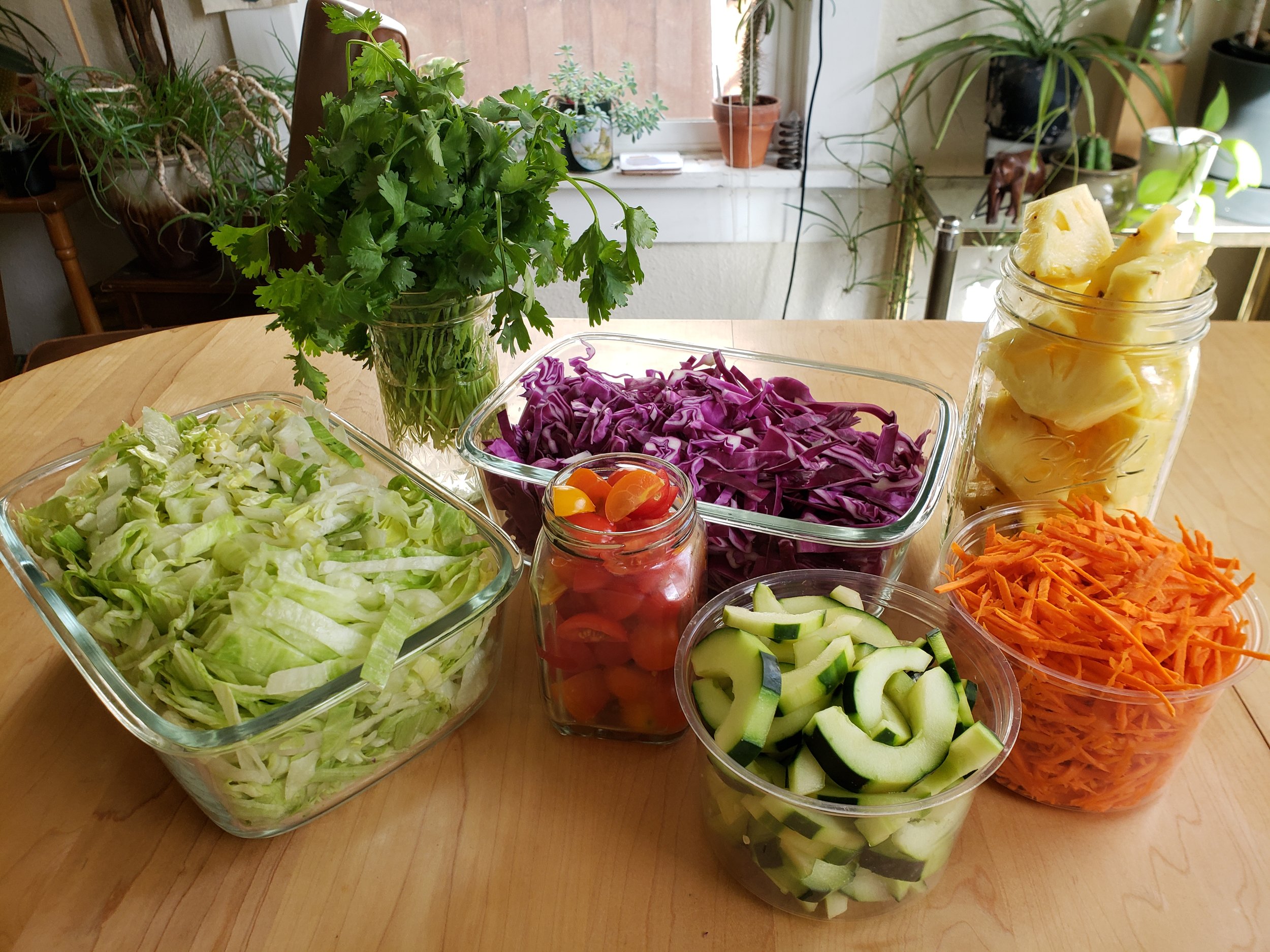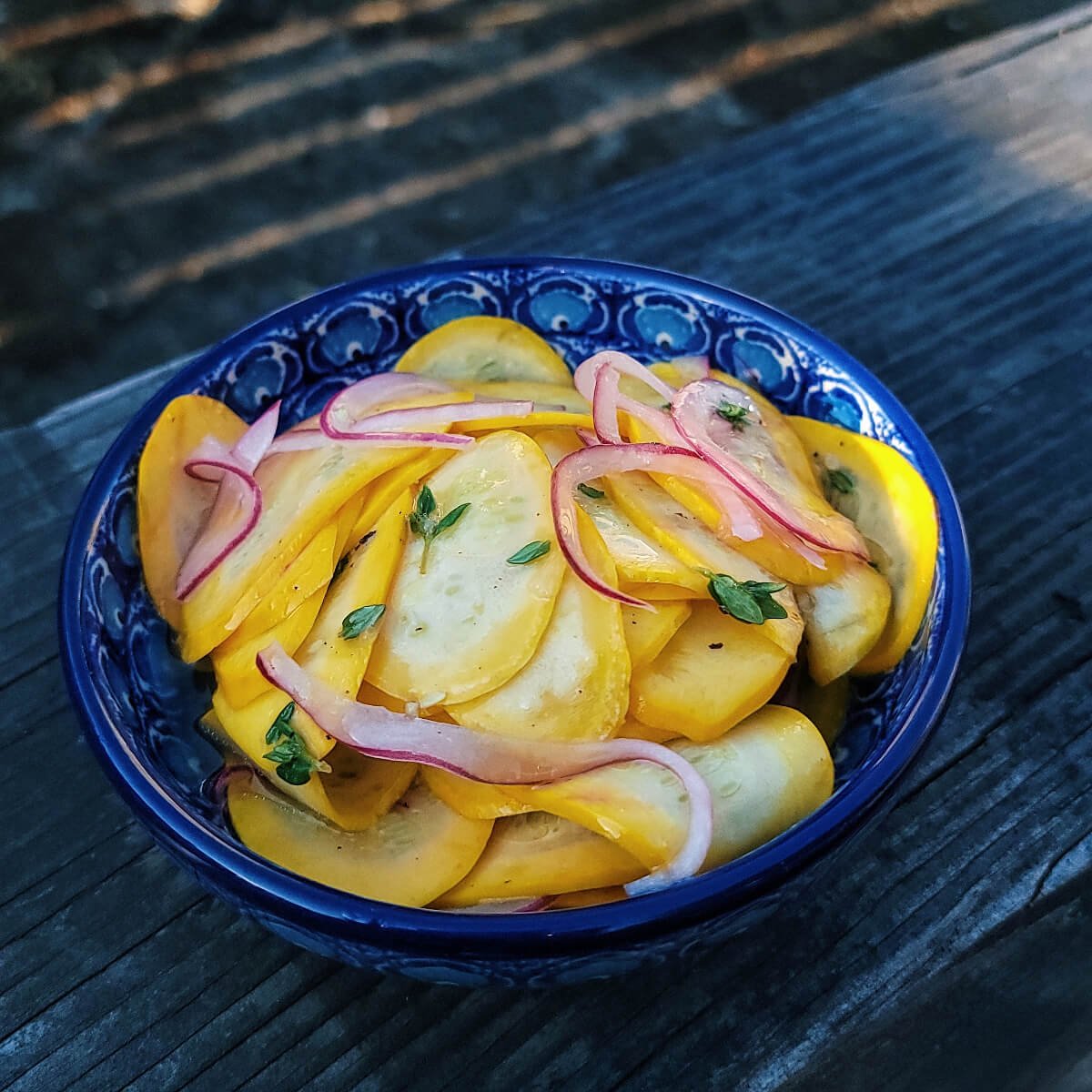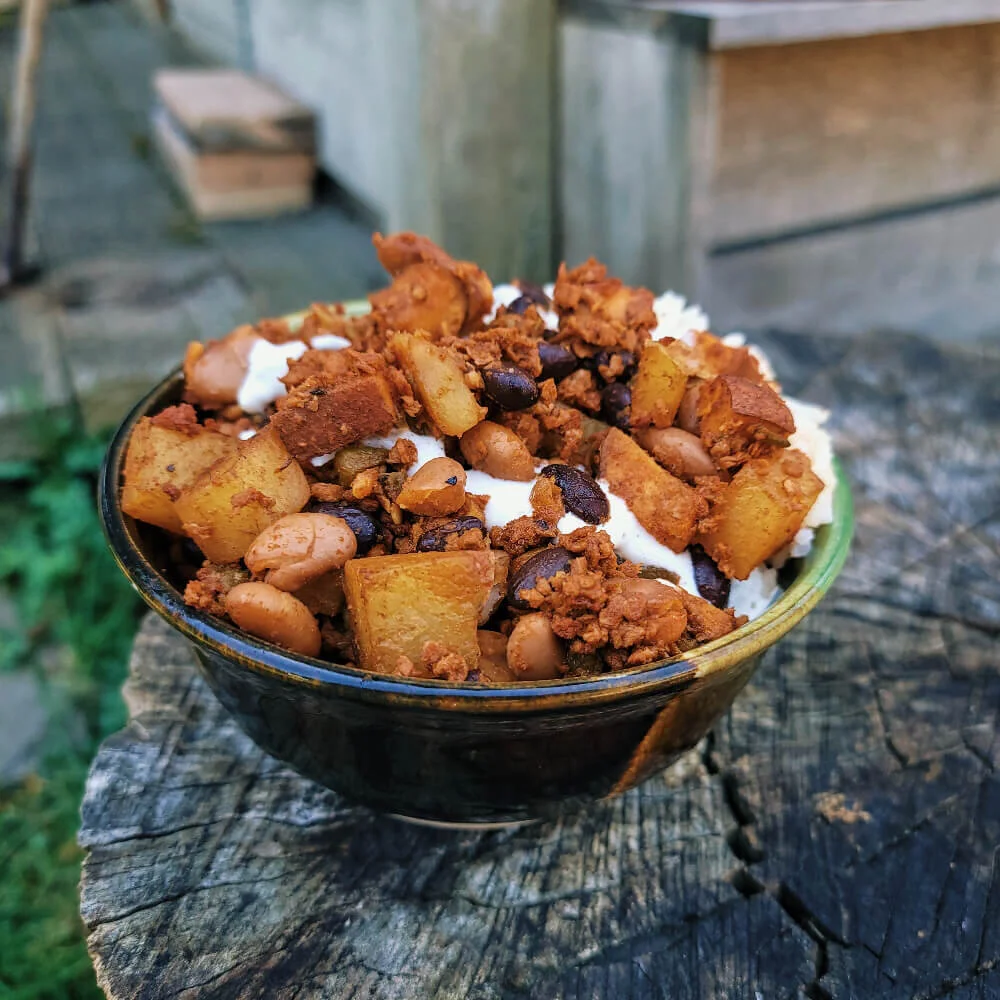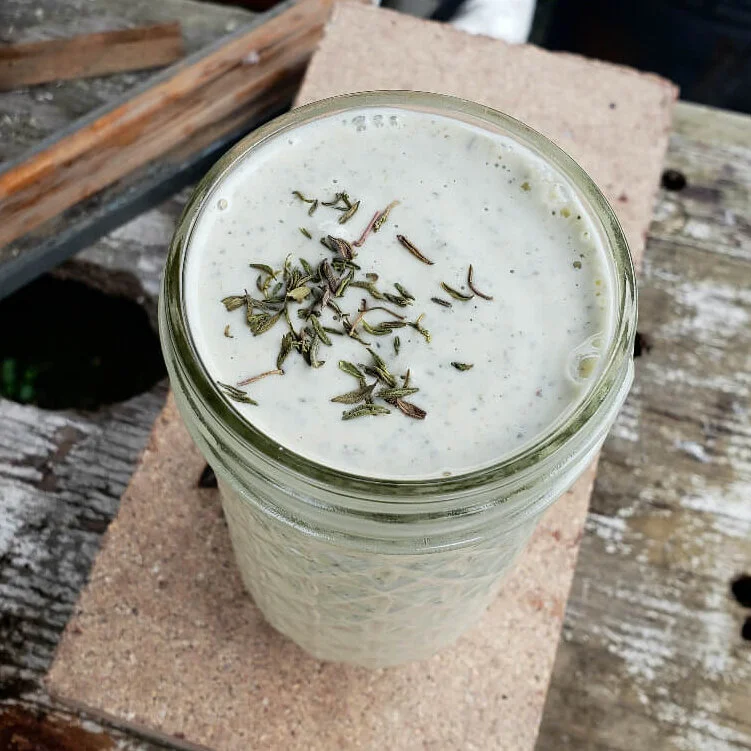Meal Building 101
This is Meal Building
All across the internet-scape are different methods, techniques, and tricks for filling your fridge with easy-to-prepare meals. Yeah, this is another one. But unlike many of them, this method of meal prep (and this blog in general) are made with ADHD, depression, Intuitive Eating, Health at Every Size, and decision fatigue in mind.
In short, Meal Building is a simplified method of meal prep that makes eating regular and delicious meals a whole lot easier.
It’s a way to incorporate more home-prepared meals while reducing the emotional and physical toll of cooking and eating. It can also be completely customized to your personal taste, budget, creativity, and time. While Meal Building may not work for every meal or for every person, it’s a great option to keep in your toolkit.
If you’re interested in exploring a beginner-friendly way to make food at home, this Meal Building 101 guide is a great place to start.
Below, we’ll touch on the good stuff like
Who Meal Building works for
Why it’s awesome
How it works
What the steps are
Some ideas to get ya started.
Who’s Meal Building going to work for?
The simplicity of Meal Building allows folks with a wide range of needs, wants, and values to utilize the basic principles, so long as they have some interest in cooking/preparing foods at home and a few tools to get started.
It’s worth mentioning that Meal Building was created from my personal perspective, values, circumstances, and access to resources. Some of these resources include a refrigerator, oven, microwave, and kitchen equipment. They also include a way to purchase, prepare, and store food. In an effort to make this method inclusive, I encourage others to take what pieces work for them, tweak what they want to, and discard the rest.
WHat’s so Great about Meal Building Anyway??
It works for the absolute beginner
It prioritizes the foods you love
It builds confidence in (& out of) the kitchen
Reduces daily decision fatigue
! ! ! ! ! ! ! ! ! Less dishes ! ! ! ! ! ! ! ! ! !
It helps develop creativity with cooking
It preserves time and energy for other things in life
So, What *is* meal building?
A marked difference between Meal Building and many other meal prep systems is that all of the ingredients (or meal components) are stored separately from one another, as opposed to having one full “meal” in each container.
The meal components you’ve got prepped in the fridge or stored away on the shelves can then be used together to make a wide range of meals as needed. Traditional meal prep systems tend to leave you stuck with a singular “recipe” you chose at the beginning of the week— Meal Building allows for a lot more variety and customization based on what you’re wanting to eat at the time.
Depending on what kinds of foods you include in your Meal Building components, this separate storage also allows you to prep for any number of days/meals/or mouths.
If this sounds a little confusing, bear with me, it’ll make more sense in a second.
For the rest of this post, I’ll be using the meal components listed below to illustrate just how Meal Building works.
Imagine that your fridge and shelves contain the following meal components:
Jasmine Rice cooked with Veggie Stock
Zesty Beans and Corn
Shredded Lettuce
Diced Tomatoes
Shredded Red Cabbage
Diced Green Onions
Cashew Nacho Cheeze
Flour or Corn Tortillas
Tortilla Chips
Dried Pasta
Canned Black Olives
Pickled Jalapenos
Canned Veggie Chili
With those components, you can mix and match them to create the following meals (and more!):
Rice and Bean Burritos or Tacos
Vegan Nachos
Yummy Rice Bowls
Fresh Salads
Cheezy Cabbage Slaw
Chips and Fresh Salsa
Nacho-style Mac n Cheeze
Chili Mac Burritos (oh yeah)
Mac n Chili Nachos (oh yeah x2)
Veggie-Packed Chili~ Can you think of anything else?
See how we created so many different meals out of the same components?!?
Once the perishable foods are prepped ahead of time, all you’ve gotta do is combine them as you wish and heat up in the microwave, on the stove-top, or eat as-is. But how does one actually make all of those meals? We’ll get to that below, I promise!
* A noteworthy note: the italicized ingredients are generally shelf-stable, last a long time, or don’t require prep ahead of time! Yay for ease!
The Meal Building Method
The Meal Building method uses a simple, four-part formula to create meals out of the components you’ve got on hand.
The Formula
The Structure: The way you’d “categorize” a meal
The Base(s): The way you’d “describe” a meal
The Topping(s): Extra deliciousness added to a meal
The Sauce(s): Something drizzled or spread over a meal
Now, let’s see what this formula looks like in practice. We’ll continue with the example outlined above and assume you’ve got all the same meal components on your shelves or prepped.
How can these meal components be arranged to build a meal?
A good example of the Meal Building formula in practice is this picture of a Rice Bowl (structure) with Beans (base), veggies (toppings), and vegan nacho cheeze(sauce).
Considering the bowl pictured above, the way I’d write out the formula is as follows:
Structure - Jasmine Rice cooked with Veggie Stock
Base - Zesty Beans and Corn
Toppings - Red Cabbage, Baby Tomatoes, Cucumber (not listed above), Green Onions, Pickled Jalapenos
Sauce - Cashew Nacho Cheeze
Since the Meal Building formula will be your guide, it’s important to understand it’s purpose. Once you’re familiar with the formula, you’ll find it much easier to create your favorite meals and brainstorm new ones.
The Formula, Explained
Let’s use two meal ideas from the example we’ve been following: Chili Mac Burritos and Vegan Nachos.
The Structure: Since this is the way you’d categorize or title a meal (e.g. tacos, rice bowls, salads, pasta), it doesn’t need to describe any particular flavors— it’s the vessel in which the flavors are carried, if you will. The structure generally involves one to three ingredients to “define” each meal.
It’s the Burrito (flour tortilla) in the Chili Mac Burritos, or the Tortilla Chips in the Vegan Nachos.
The Base(s): This is where the most prominent flavors or most noteworthy components are described (e.g. chili, bean mixtures, roasted veggies). The base generally involves zero to infinite components, but I recommend keeping it minimal for ease. If you’re preparing much of your food at home, these tend to be items that require a bit more effort to make, but they can also be shelf-stable or frozen foods.
It’s the Veggie Chili (canned or homemade) and the Mac (cooked pasta) in the Chili Mac Burritos, or the Zesty Beans and Corn in the Vegan Nachos.
The Topping(s): These are ingredients that are added to a meal that require little to no prep and are generally fresh fruits, veggies, nuts, spreads, dips, or salsas— you can use zero to infinite toppings but keep it within reason. They’re a great way to add some freshness to a meal and make it easy to incorporate veggies into dishes that wouldn’t otherwise include them.
It’s the Veggies (Red Cabbage, Green Onions, and Pickled Jalepenos) in the Chili Mac Burritos, or the Veggies (Baby Tomatoes, Green Onions, Pickled Jalepenos, and Black Olives) in the Vegan Nachos.
The Sauce(s): It’s hard to choose a favorite part of my meals, but usually it’s the sauce. You can use as few or as many as you’d like, and they don’t have to be super ”saucy”, either. Things like citrus juice, vinegar, or dressing work just fine. I enjoy making my own most of the time but store bought varieties can be just as great and sometimes more convenient.
It’s the Cashew Nacho Cheeze in both the Chili Mac Burritos and the Vegan Nachos.
The Meal Building formulas for Chili Mac Burritos and Vegan Nachos are as follows:
Chili Mac Burritos
Structure - Flour Tortilla
Bases - Canned Chili, Cooked Pasta
Toppings - Red Cabbage, Baby Tomatoes, Green Onions, Pickled Jalapenos
Sauce - Cashew Nacho Cheeze
Vegan Nachos
Structure - Tortilla Chips
Base - Zesty Beans and Corn
Toppings - Baby Tomatoes, Green Onions, Pickled Jalapenos, Black Olives
Sauce - Cashew Nacho Cheeze
Finding your Preferences
The example we’ve been following thus far was formed when I brainstormed the kinds of foods I enjoy most and how I could make them at home with ease. But what if you’re not into Beans or Rice or Cashews or Veggies?
This blog offers a multitude of options for incorporating into your Meal Building toolkit (browse the recipes here), but they are certainly not the only things you can do with it.
The good thing about Meal Building is that it’s fully customizable, meaning you can include whatever foods, recipes, or meals you enjoy most. Basically, you don’t have to follow anyone’s preferences but your own and whoever else you’re preparing food for.
The easiest way to start Meal Building is to come up with a list of foods that you’re already excited to make and eat on a regular basis. Break down the meals you’re familiar with into their individual components and fill in the blanks of the formula, that way you know what ingredient's you’ll need to have later.
Build Your Own Meal
Structure - ______________________
Base(s) - ________________________
Topping(s) - _____________________
Sauce(s) - _______________________
To get your creativity flowing, I’ve listed out some of my favorite meal components:
Structures
Rice Bowls or Quinoa Bowls - Cooked Rice or Quinoa, any variety
Salad - Red or Green Leafed Lettuces, Shredded Cabbage, Kale, Arugula
Baked Potatoes or Fries
Tacos - Corn Tortillas, Flour Tortillas, Lettuce Leaves, Cabbage Leaves
Burritos - Flour Tortillas, Brown Rice Tortillas, Collard Leaves
Pasta - Wheat or Brown Rice Past
Nachos - Corn Tortilla Chips
Bases
Beans - Garbanzo, Black, Pinto, White, Kidney
Quinoa - Cheezy Quinoa
Roasted Potatoes - Any variety
Bean Mixes - Zesty Beans and Corn, Roasted Sweet Potato & White Beans
Chili, Soups, or Stews - Homemade or store bought
Roasted Veggies
Leftovers
Frozen Dinners
Toppings
Shredded Lettuce
Shredded Cabbage
Diced Tomatoes
Sliced Cucumber
Sliced Beets
Diced Green Onion
Diced Mango
Shredded Carrots
Corn
Avocado
Pickled Jalapenos
Dips or Salsas - Hummus, Pico de Gallo, Sauerkraut, Guacamole
Sauces
Sweet & Smokey Tahini Dressing
Peanut Sauce
Store-bought Dressings
Lime or Lemon Juice
Vinegar or Oils
If you’re entirely new to cooking, you may have to spend a bit of time brainstorming and researching the kinds of meals you’d like to have at home. I’m working on a thorough guide for those who are starting from square one, but for now, I recommend browsing the recipes on this blog, in cookbooks, or anywhere else on the internet. I also suggest following the above guidance as much as you can, and staying tuned for the updated post. Thanks for your patience! I believe in you!!!
The 3 weekly Tasks
Like all forms of meal prep, Meal Building requires some weekly planning to ensure your success. First, you’ll need to decide on your meals for the week. Second, you’ll need to grocery shop. Third, you’ll need to prep any structures, bases, toppings, and sauces.
The more familiar you become with these three tasks, the easier and quicker Meal Building will become, I promise.
1 - Decide on Your meals for the week
Okay, this is probably the most difficult task of all three so be patient with yourself. Planning meals for an entire week (or even just one day!) can be incredibly daunting at first. Once you get the hang of how it’s done, though, Meal Building becomes easy breezy. There are a few important things to consider before embarking on this first step if this you’ve never used the Meal Building method before.
Firstly, be realistic! If you’re not already making most of your meals at home, don’t expect to just jump into Meal Building and have it all go perfectly— start with one meal a day you want to prepare for and keep your components simple at first. A good starting plan for your first time Meal Building could include 1-2 Structures, 1-2 Bases, 1-5 Toppings, and 1 Sauce.
Secondly, I usually recommend keeping perishable foods to a five/six-day supply, max to keep your food from getting yucky before you have a chance to eat it. After a few weeks you’ll have a better idea of how much food you’ll be able to eat in that time. In the meantime, if food spoilage is a large concern, stick to as many shelf stable items you can and reduce the number of toppings or bases you make during your first few weeks of Meal Building. Also, dated and labeled sticky notes are your friend if you struggle with forgetfulness, have opaque storage containers, or if food storage is overcrowded.
Third, please, please, please make a list of meal ideas (and try not to lose it!)! Having a record of meal ideas will remind you of the different combinations you can make out of the foods on-hand. This is particularly useful if you’re feeling uninspired or forget what you can do with all the stuff you bought at the grocery store. Favorite meal lists are also to refer back to when you decide on your meals in the following weeks or if you want to switch things up in the future.
Okay, now that we got those helpful tips out of the way, let’s get to actually making your list of meal ideas for the week. If you’ve already got meals you want to try in mind, by all means, write your weekly plan! I recommend writing out each meal you’d like to enjoy throughout the week using the Meal Building formula for consistency (and ease later on)
If you’re unsure about what meals to start with, refer back to the list of meal ideas you created earlier and pick something that is within your current comfort zone and skill set in the kitchen. Keep it as simple as you need to.
2 - Grocery Shop
Hooray! You have your weekly plan at the ready and now it’s time to get the ingredients to make it a reality. If you’ve already got a pretty good idea of how to create a solid grocery list, you can skip the following bulleted list. If you’re new or unsure about making grocery lists, don’t skip ahead!
Using your weekly plan, write down all the ingredients needed to make each meal come together.
Check your pantry and fridge to take stock of what you already have. Double check to ensure the ingredients are still good— toss any that aren’t. Cross the items off your ingredient list that you don’t need to get more of.
Revisit any recipes or meal ideas to make sure ingredients weren’t skipped. Write down anything missed.
If you plan to grocery shop for any meals besides Meal Building, add any other fresh produce, snack foods, or meal ingredients (separate from meal building) needed.
Heck yeah, you’ve just made your first Meal Building grocery list!
Weekly grocery shopping is the way to go if you plan to eat fresh produce regularly. If you're a planner, it helps to stick to a specific day of the week. If you're a procrastinator, be real with yourself. Figure out when you're going to lose motivation to shop and get your butt out there before you reach the point of no return.
Take your list with you (don’t forget it! sticky notes!!) and hit the aisles.
For more information on how to plan a trip to the grocery store, stay tuned for a follow up post.
3 - Prep your Structures, Bases, Toppings, and Sauces.
So to avoid interruptions or other commitments taking precedent, you’ll want to carve out about 1-2.5 hours to take care of all this prep. I know, that’s a pretty big time range. The actual time required will vary depending on your familiarity in the kitchen and volume/complexity of food being prepped.
I find that this prep is easiest in one go, but do what you can with the schedule and energy you’ve got. Feel free to break it up over the weekend or during the span of a single day.
If you’re feeling reluctant to designate this much time to prepping food, think about it like this:
Imagine huge bowls of shredded cabbage, freshly cooked rice, delicious dressing, and flavorful beans in your fridge. How likely are you to whip up a rice bowl? Now picture all those veggies and fruit in the plastic bags you took them home in, unwashed, unchopped, unprepared. You still gonna make a rice bowl?
Whatever you prep, you're significantly more inclined to grab in a pinch after a long day. Carve out the time, roll up your sleeves, put on a podcast you've been wanting to listen to all week, and get to choppin.
I like to start the foods that take the longest, first, to save time. These are typically structures and bases. Doing this allows me to prep fruit, veggies, and sauces as other things cook. This requires a bit of multitasking but nothing too outrageous. Especially if you’ve got your handy dandy weekly plan!!!!
Store your prepped fruit and veggies in airtight containers in the fridge, don't leave it uncovered and let all the goodness go to waste!
If you've chopped anything with a high-water content like tomatoes or lettuce, place a paper towel at the bottom of the container to soak up excess liquid. Nobody likes soggy lettuce.
>> For more information about the prep step, read this post on Making Meal Prep Enjoyable.
4 Favorite Meals to Build
These are some of my go-to ways to utilize Meal Building besides the example we used in the beginning. I make these meals on a very regular basis and still love them just the same. Try them out yourself!
SUMMERY FRESH RICE BOWL
Structure - Jasmine Rice with Veggie Bouillon
Base - n/a
Toppings - Cucumber, Red Cabbage, Baby Tomatoes, Alfalfa Sprouts, Green Onion, Mango
Sauce - Cashew Lime Crema
NACHO-STYLE RICE BOWL
Structure - Jasmine Rice cooked with Veggie Bouillon
Base - Zesty Beans and Corn
Toppings - Pickled Jalapenos, Baby Tomatoes, Green Onion, Guacamole
Sauce - Cashew Nacho Cheeze (& Cashew Lime Crema if I’m feeling real ambitious)
Stuffed Sweet Potato
Structure - Baked Sweet Potato
Base - Zesty Beans and Corn
Toppings - Green Onions, Baby Tomatoes, Pickled Jalapenos
Sauce - Cashew Lime Crema
Loaded Potato Fries
Structure - Baked Yellow Potato Fries
Base - Zesty Beans and Corn or canned Veggie Chili
Toppings - Red Cabbage, Pickled Jalapenos, Baby Tomatoes
Sauce - Cashew Lime Crema or Cashew Nacho Cheeze
Let's wrap this up
If you made it to the end of this long as heck post, congratulations!! Even if you never give Meal Building a go, you’ve triumphed in other ways— but I do hope you’re inspired to try it out.
Stay tuned, I've got plenty more resources coming on the topic. Everything from my personal favorite Meal Building recipes, a closer look into what my kitchen actually looks like, and more posts on how to make Meal Building easier.
So, are you ready to get started?





















This easy mealtime bowl of goodness warms your heart, your belly, your soul. A beginner-friendly recipe and longtime fav for quick weeknight dinners.